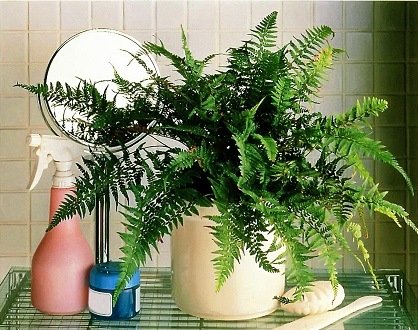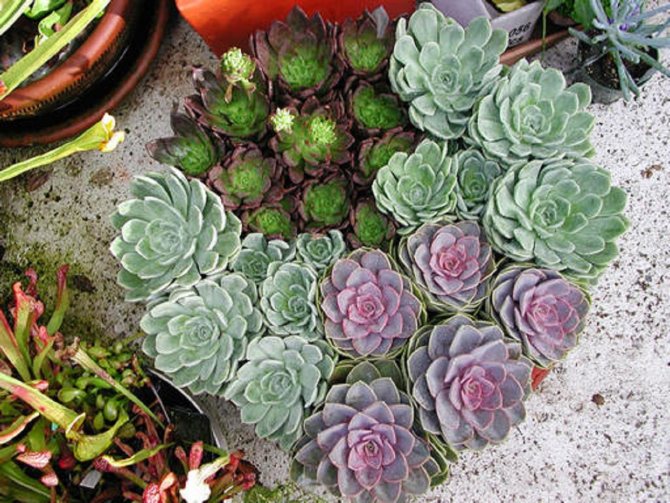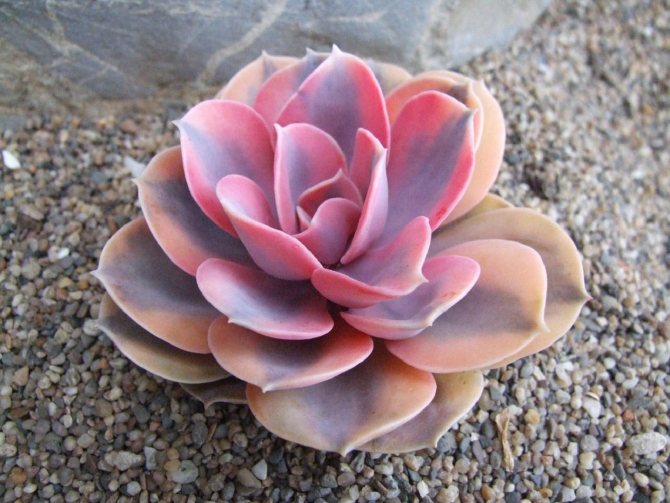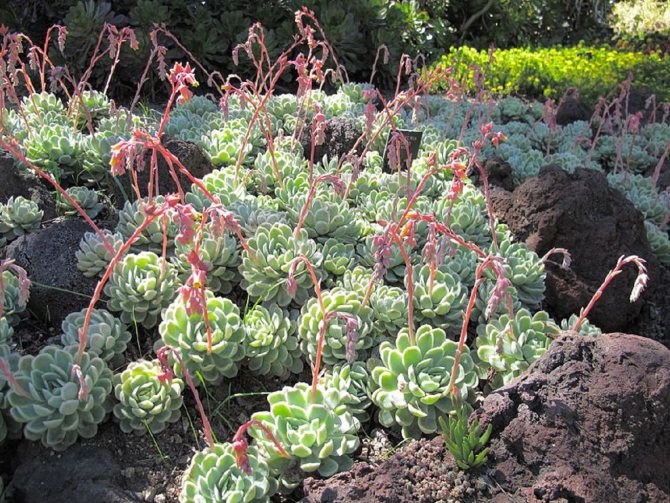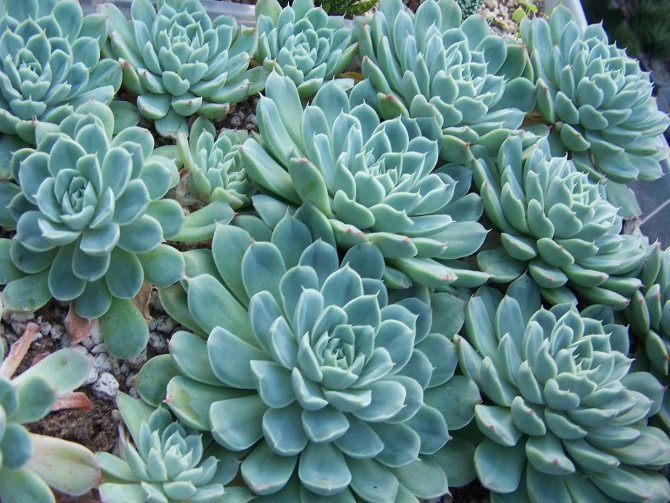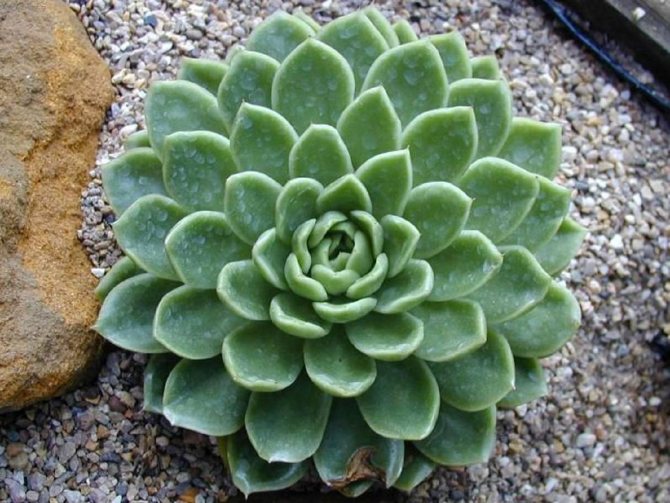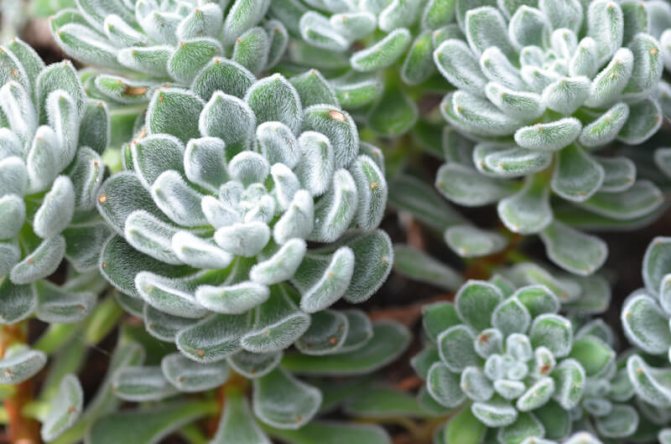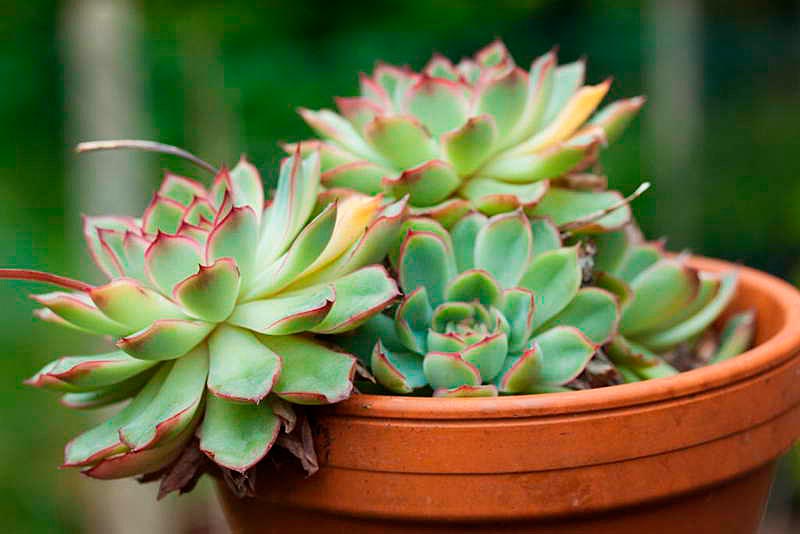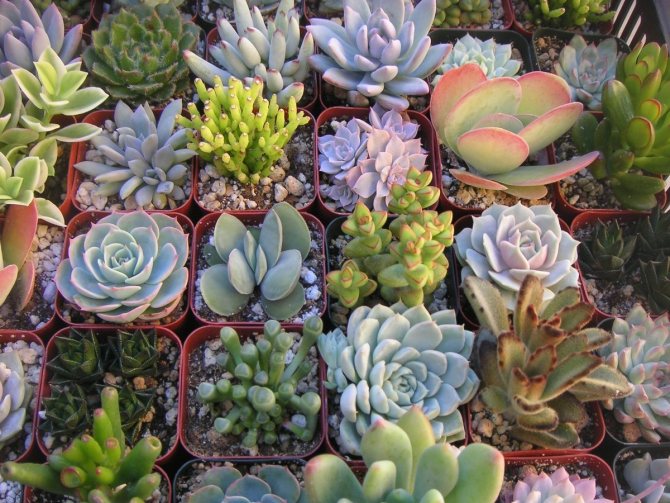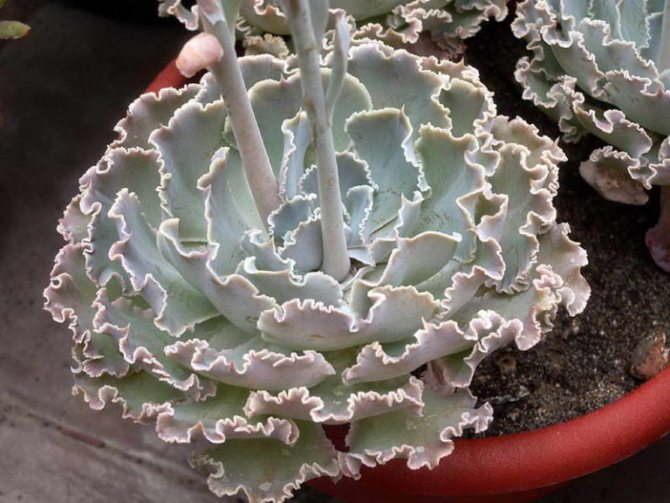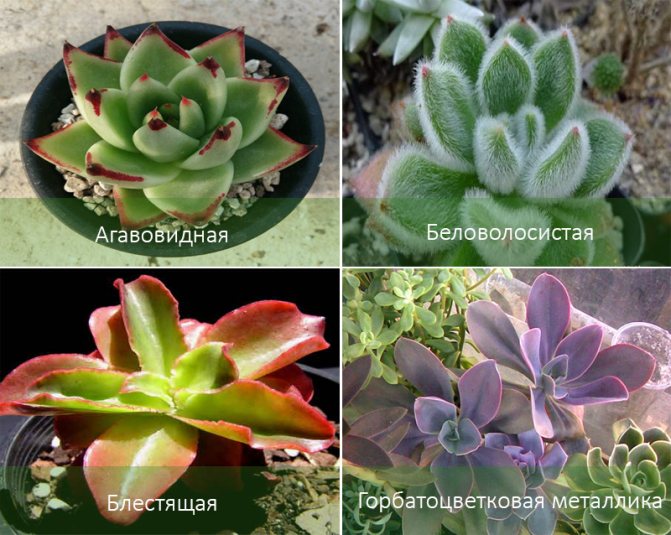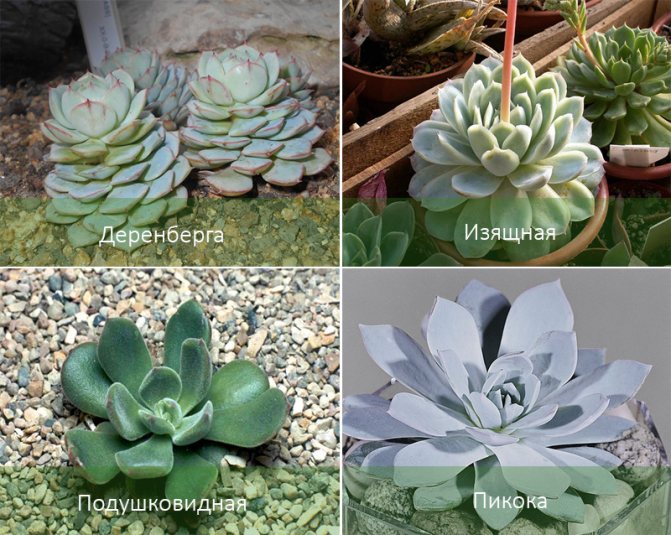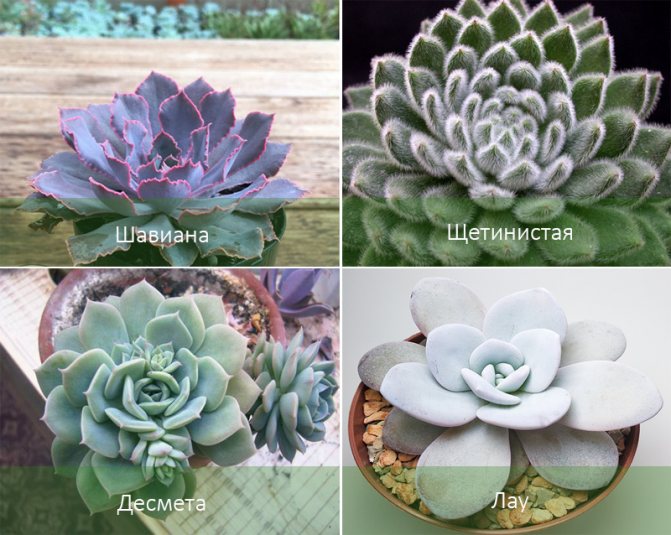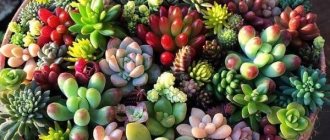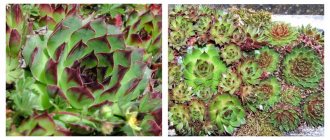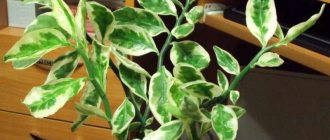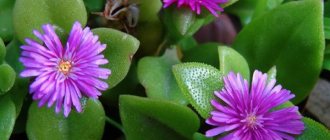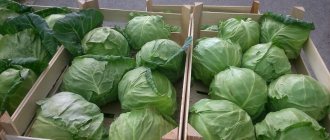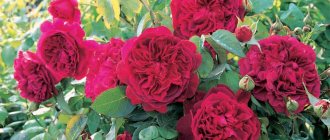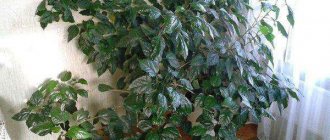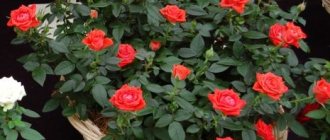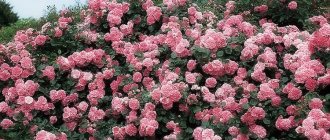Echeveria is a succulent plant from the Tolstyankov family. In nature, there are about 200 species. The natural habitat of Echeveria is the arid regions of America (Mexico, Peru, California).
Echeveria is a stemless plant, at the ends of which dense rosettes of fleshy sessile foliage are formed, resembling a rose. Therefore, the plant is also called "stone rose". Evolving, culture has developed various ways to protect itself from the scorching sun. On the surface of the leaves (depending on the species) there may be a waxy bloom, pubescence, dense arrangement. For its unusual appearance, Echeveria is often used to decorate home interiors. It is not picky to care for, therefore it is suitable for growing by both experienced and novice growers.
Botanical dossier
Most echeveria are low shrubs or herbaceous perennials with a shortened stem and rosette of fleshy leaves, pointed at the top. All succulents of the genus are large light-lovers and tolerate the summer heat perfectly, acquiring a slightly pinkish shade of leaf blades. In the circumference, the rosettes grow depending on the species: there are both perfect crumbs no more than 3 cm, and giants about 40 cm in diameter. The surface of the leaves is often covered with a soft hairy pubescence or a waxy silvery-bluish bloom that prevents moisture loss.
Indoor echeveria in March or April develop a long - sometimes up to 90 cm - peduncle, towering over the rosette. Small bell-shaped flowers of cream-white, lemon, orange, coral color are collected in spike-shaped or paniculate inflorescences. However, many owners of succulent collections remove flower stalks, believing that they only litter and do not represent any particular decorative value. Indeed, the graceful proportional rosettes of echeveria will quite compete with the flowering of even very beautiful plants.

How to plant echeveria correctly
Inexperienced flower growers often ask questions whether it is worth replanting Echeveria immediately after purchase. The substrate in which most succulents are transported, including Echeveria, is not suitable for their long-term cultivation.
After the end of the quarantine period, which is absolutely necessary for the plants that have arrived at the house, in order to make sure that there are no diseases or damage to pests, Echeveria must certainly be transplanted. The only exceptions are flowers purchased in winter. For them, transfer work can wait until early spring.
Only young specimens are transplanted annually. Mature plants tolerate this process more difficult: firstly, the waxy layer on the foliage is disturbed, and secondly, the fragile filamentous root system is damaged. And in fact, and in another case, the flower recovers for a long time after transplantation. That is why adult Echeveria either transfer from one pot to another, or simply change the top layer of the earthen coma.
Choosing a flower container
The echeveria pot must have drainage holes. By itself, the vessel is chosen shallow - the roots of the plant are poorly developed and are located in the upper layers of the soil. The diameter of the container is chosen 3-4 cm larger than the circumference of the outlet.
The material of the pot does not play a special role, but due to the fact that for Echeveria it is important that water does not stagnate in the vessel, preferably a container made of clay or ceramics. However, for punctual growers who are able to organize the watering regime for the succulent correctly, plastic pots are also quite suitable for growing a flower.
Compilation of soil mixture
Echeveria grow well in substrates for succulents or cacti. A flower grower is able to prepare a mixture for planting a plant on his own. Components typically include:
- 3 parts of clay-sod land;
- 1 part of leafy rotted soil;
- 1 part coarse river sand;
- 1 part brick chips.
At the bottom of the flower container, a layer of expanded clay drainage is poured on a third or quarter of the height, then a well-mixed soil mixture. The plant is buried in it so that the root collar is at the level of the surface of the earthen coma. A layer of medium-fine gravel is often laid around it, both for decorative purposes and for better air access to the roots.


Pot planting succulent at home
After buying a potted plant, you must immediately transplant it to a permanent place. The soil in which Echeveria is put up for sale is not always suitable for long-term cultivation at home. For potting a succulent, you will need nutritious soil, which will be based on the following compositions: garden soil (3 parts), pebbles (1 part), the same amount of peat and a small amount of charcoal. In the wild, Echeveria grows in rocky or stony soils, so try to maximize natural growing conditions for it.
To lighten the soil at home, pebbles, expanded clay or pebbles are suitable. Sand and vermiculin will not work as these materials will retain moisture. Pebbles of the middle fraction are mixed with the soil and laid out as a drainage layer.
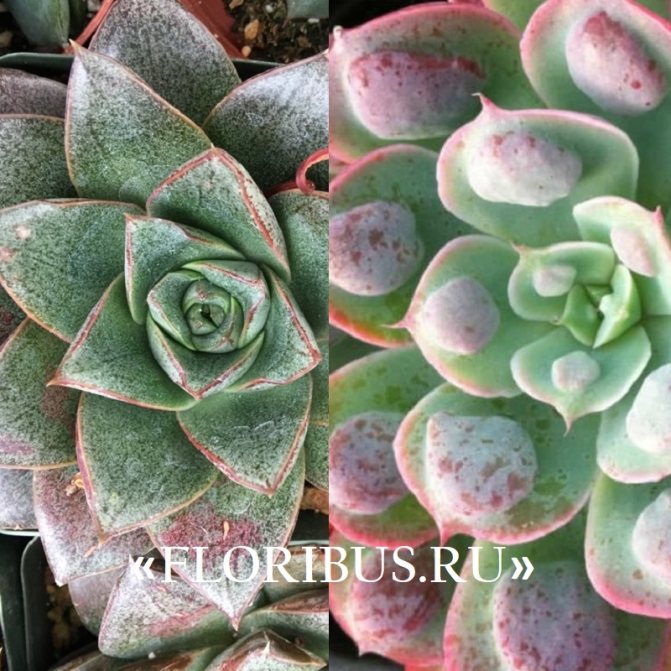

Placing echeveria in the house
The plant is very light-requiring. For him, the direct rays of the sun are not afraid, even in the strong sun the succulent does not suffer, but also improves its decorative effect. The edges of the leaf plates acquire a purple hue, and the petals of blossoming flowers are redder in Echeveria, located on the southern windowsills, in contrast to the same variety, but blooming with yellow-orange bells in poor lighting.
The echeveria flower is considered a short-day plant, but for its successful flowering, it is also necessary to comply with the condition of the duration of good lighting during the day for 12-13 hours. In summer, the succulent is transferred to the garden and left where there is no shade for most of the day. Often they transfer it to the southern alpine hill.
The temperature regime during the active growing season is maintained within the range of up to 27 degrees Celsius. With such indicators of the thermometer, additional measures are not required to adjust the irrigation regime. The plant copes well with both high temperatures and dry air. In winter, Echeveria begins a dormant period, and it is advisable to lower the temperature in the room to 10 degrees Celsius, so that with the arrival of spring, flower buds are laid in it.


Reproduction of echeveria by cuttings, leaves, rosettes and seeds
Reproduction is done by cuttings, rosettes, seeds and leaves.
Echeveria can be successfully propagated by cuttings. The leaf cutting must be rooted in moist soil or coarse sand. After about 30 days, the flower will start to take root.
Echeveria grows quite successfully as a leaf. It is necessary to separate the leaf from the mother plant. To prevent it from festering, dry it for about a week. After this procedure, place the sheet with the outside on damp soil, in a room with a temperature of 25 ° C. When a small rosette appears, the plants need to be planted in different pots.
Echeveria can be propagated by rosettes.Separate the rosette from the adult flower and treat it with crushed coal, then dry it for 12 hours. Then plant in wet sand. For this type of reproduction, the earlier appearance of peduncles is characteristic.
Echeveria can be grown from seeds, this method is considered the most difficult. When the plant blooms, pollinate the flowers and harvest the seeds from them when they are ripe. Next, you need to prepare the sour soil for planting seeds. They need to be superficially placed on the soil, not sprinkled with earth. Send the container with seeds to the sunny side in a cold place. The temperature should be at least 25 ° C, high humidity is mandatory. It is best to germinate seeds in a container with a transparent lid and a good drainage system. Thanks to this method of reproduction, many sprouts can be obtained at once.
See what the echeveria flower looks like in the photo:
Succulent care
Like many succulents, Echeveria does not require the close attention of the grower.
Watering
Even in extreme heat, the plant is watered only after the soil mixture has completely dried. Humidification should not be abundant, in addition, it is necessary to ensure that moisture does not get inside the outlet and does not stagnate in the flower container, but all flows into the pallet. Excess water is drained from it half an hour after watering. The frequency of watering in summer does not exceed once a week; in winter, the flower is very rarely moistened, only so that the leaves do not begin to lose turgor.
The flower does not need spraying and measures to increase the humidity of the environment, and they are even harmful to varieties with pubescent foliage. From dust, the leaf blades are wiped with a damp cloth, if their surface is not covered with a wax coating or soft fibers.
Top dressing
Echeveria is fed only during the active growing season; during winter dormancy, the supply of nutrients to the plant is not replenished. Once a month, mineral fertilizers are applied for succulents or cacti, organic fertilizers are practically not used. Excess nitrogen is also undesirable because it weakens the immunity of the succulent in relation to fungal diseases.
An overdose or overfeeding often provokes a problem such as damage to the delicate roots of Echeveria, in other words, a chemical burn of the root system. If the top layer of the substrate changes in a timely manner, it is quite possible to do without top dressing.
Pruning
Echeveria practically does not need formative pruning, with the exception of semi-shrub species. However, the plants grow over, the lower leaves die off, they should be removed in a timely manner so as not to spoil the beautiful appearance of the flower. Withering inflorescences are also cut off in time, if the goal of pollination and obtaining seeds was not pursued. Mature plants with a bare bottom stem rejuvenate by cutting off the top for its subsequent rooting.
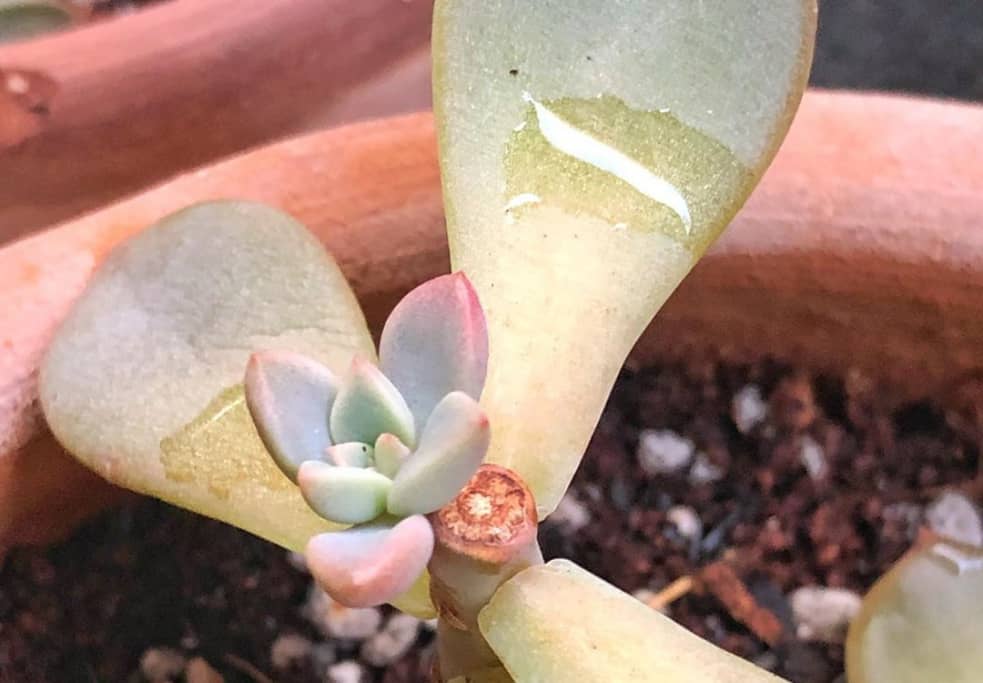

Growing problems
If the winter for Echeveria was too warm and dimly lit, the rosettes stretch out, the leaves sit loosely, loosely, too pale at the base. They will not change their appearance if conditions are improved, so it is easier to renew the plant from a leaf (re-root individual leaves).
The most common problems with Echeveria are due to improper watering. Do not water at the correct frequency by day or hour. The guideline for irrigation is exclusively weather conditions, temperature and soil drying rate. Any violations - overdrying or waterlogging can cause wilting, wrinkling and death of leaves. Watch climate changes, make adjustments. The most dangerous moments are the off-season periods, for example, when the heating is turned off in the spring or a cold snap sets in in August - changes in temperature and humidity greatly affect the rate of evaporation of water from the soil and irrigation is needed more rarely.
On especially hot days in summer, in small pots, the earth can dry out in literally hours.If you inadvertently forget to open a window on a sunny balcony, the plants will burn or suffocate. Soldering overdried specimens will not help; in order to protect the plants from drying out in a hot period, do not leave them in sunny places or shade the pots, wrapping them in white paper; transplant on time (if the ends of the leaves protrude beyond the edge of the pot); water in the morning, if by the evening the heat does not subside and the soil is dry, water again.
In general, Echeveria can be characterized as follows: these are drought-resistant plants when there is no extreme heat. The ideal place for them in the apartment is the sill of the southeastern window or a very bright eastern window.
Diseases and pests
Mealybugs, fungal infections (powdery mildew) and root rot (from constant dampness) pose a serious danger.
To protect the plants from the worm, sterilize the soil before planting. Regularly inspect the plants displayed on the open balcony or in the garden, with particular attention to the root zone, the base of the outlet. Aktara treatment (spraying and watering).
Powdery mildew becomes noticeable in the form of a whitish, as if dusted with flour, plaque on the leaves. It can get in with the wind if infected trees and shrubs grow under the windows, in this case, the leaves should be treated with fungicides (for example, Topaz).
To avoid root and stem rot will help the regulation of irrigation according to climatic conditions and correctly selected soil (drying out no longer than 2 days), and as a preventive measure it will not hurt to water the soil with a solution of biofungicides (phytosporin, trichophyte, etc. preparations) in the off-season.
Breeding features
The plant is propagated in several ways. The most labor-intensive is considered to be seed. The lightest and most common are leaf cuttings and daughter rosettes, and for semi-shrub species and varieties, propagation by stem cuttings is also used.
Sowing seeds
The planting material is sown in a peat-sand mixture around the end of February. A semblance of a greenhouse is erected on top, covering it with either plastic wrap or glass. Maintain the temperature in the room where the seeds germinate, approximately in the range of 20-22 degrees. The soil is moistened with a spray bottle and the glass or the edge of the film is constantly lifted for ventilation, so that mold does not appear on the surface of the soil mixture.
Seedlings are shown in 12-15 days. They are grown until 2-3 leaves appear and dive into separate pots filled with a mixture of leafy earth and sand, taken in a 2: 1 ratio. Rosettes that have reached a diameter of 2-3 cm are transplanted into containers corresponding to their size and filled with earth mixture for growing adult plants.
Cuttings
For planting cuttings, pots with a diameter of 7-9 cm are prepared and filled with either clean sand or compost soil or mix these components, taking in equal volumes. Before planting, both leaf and stem cuttings wither for several hours. Usually, rooting them always turns out to be effective. The best time for cuttings is from March to May, but propagation of Echeveria by cuttings is allowed throughout the growing season.
Know-how of cuttings
Some succulent plant collectors use a rather unusual way of rooting cuttings. Choose a rosette that requires rejuvenation, but healthy and strong, gut it on the leaves. The leaf blades are torn off by hand, without the use of tools, but carefully and slowly. Separate together with the so-called "heel", on which the meristem tissue is located.
The sheets are folded into a plastic tray and placed in a warm place. After a month, first roots appear on them, and then a microscopic rosette, which is transferred to the surface of the soil mixture for rooting.
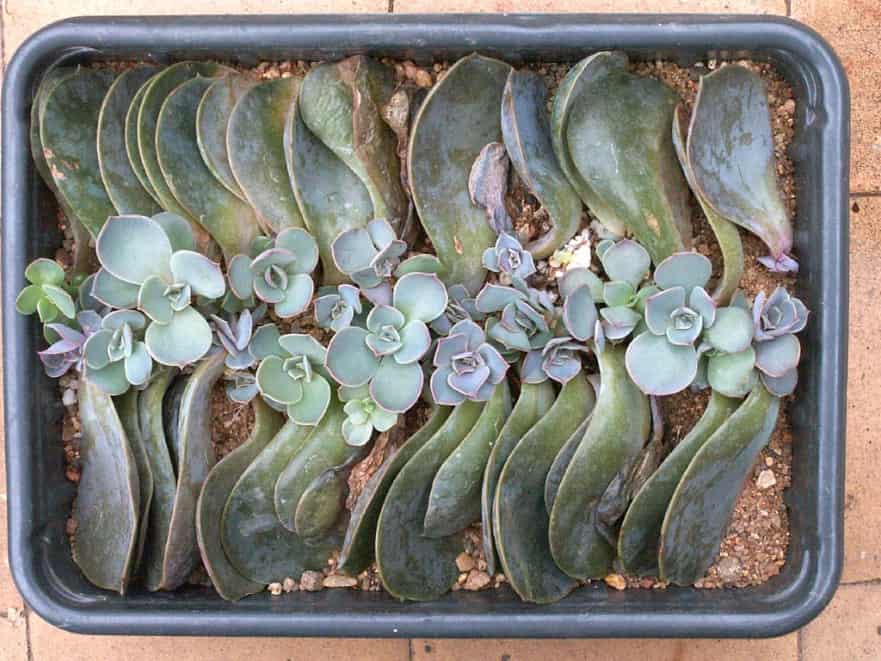

Reproduction by children
This method is considered the most burdensome.In the spring, during transplantation, daughter rosettes are simply separated from the mother plant, which are formed in many species of Echeveria. They are planted in pots appropriate for their size, filled with substrate for adult specimens.


Soil mix for succulent
The most important thing when choosing a soil is that it is maximally moisture absorbing. Heavy mixtures are not suitable for growing Echeveria. The plant has not large roots, which are difficult to survive in such conditions, they can begin to rot, which will lead to the death of the perennial.
To determine whether a soil mixture is suitable for a succulent or not, there is a very simple way: take a little earth in your palm, squeeze it with force and unclench it. If the soil remains a lump, then it is not suitable for growing perennials, if it crumbles, then you can easily use it for planting or transplanting echeveria. It makes no sense to lighten the soil with sand, in large quantities it will retain moisture and cause rotting of the rhizome. In general, river sand is not recommended because it is too fine. To lighten the soil, it is better to take pebbles.
If you chose a purchased mixture, then ready-made compositions for succulents or cacti are suitable, but they will also need to be lightened with small stones. In any case, perennials growing on light, crumbly soil give the best growth rates.


Diseases and pests
For echeveria, excess irrigation moisture is dangerous, provoking rotting of the root system. The problem occurs more often in winter during cool content. The ingress of water into the center of the outlet also causes decay, and on the leaves covered with a waxy coating, it provokes the appearance of spots.
The lack of moisture affects the elasticity of the leaf blades. After prolonged drying, they become thinner and wrinkle, although after the restoration of the previous irrigation regime they return to a healthy state again.
Among the pests on Echeveria, mealybugs and phylloxera are most often seen. They are destroyed with systemic insecticides, spraying the rosettes with a fine spray, so that the pubescence or waxy coating does not suffer too much.
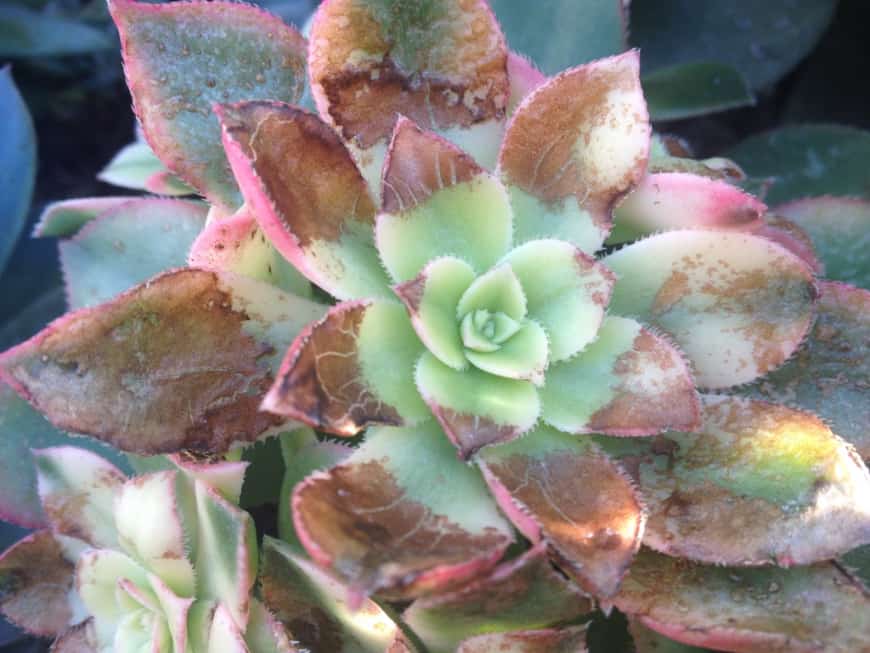

Types of echeveria for indoor floriculture
The genus Echeveria of the Tolstyankovye family consists of approximately 170 species of perennial herbaceous or semi-shrub succulents. Few are grown at home.
Echeveria agave (E. agavoides) is a herbaceous succulent with a small stem. Oblong leaves of a silvery-pale green hue are collected in a dense rosette. The tops of the leaf blades are pointed, with a reddish tip.


Echeveria agave Miranda (E. agavoides Miranda) is a spectacular hybrid with rosettes spread on the ground, similar to a lotus flower. Many varieties have been bred with an amazing shade of leaves - purple, blue, pale pink, scarlet, thick yellow, silver.
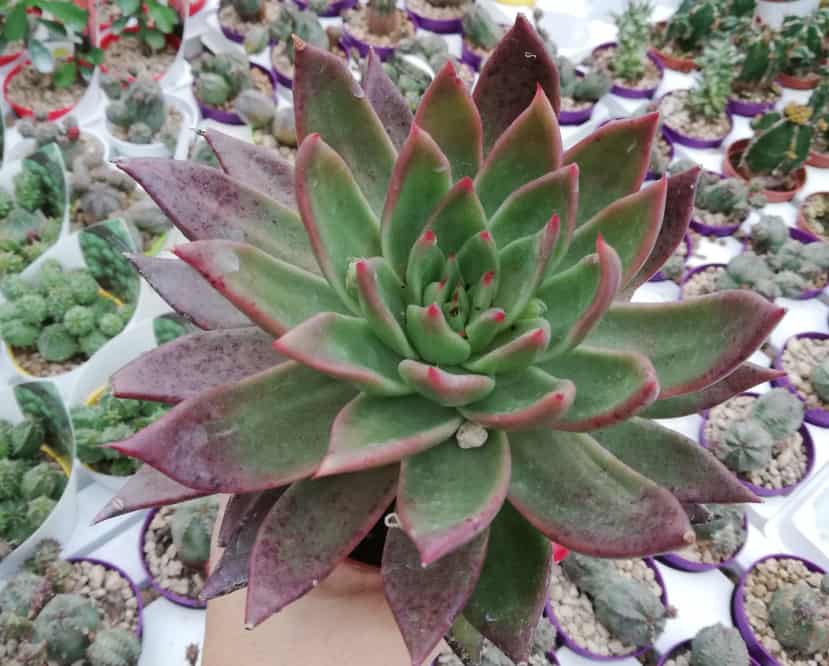

Echeveria graceful (E. elegans) is a perennial succulent with a short stem - no more than 5 cm - and a large number of daughter rosettes. The foliage is medium-sized, up to 6 cm in length, light emerald, with a slight bluish-silver waxy bloom.
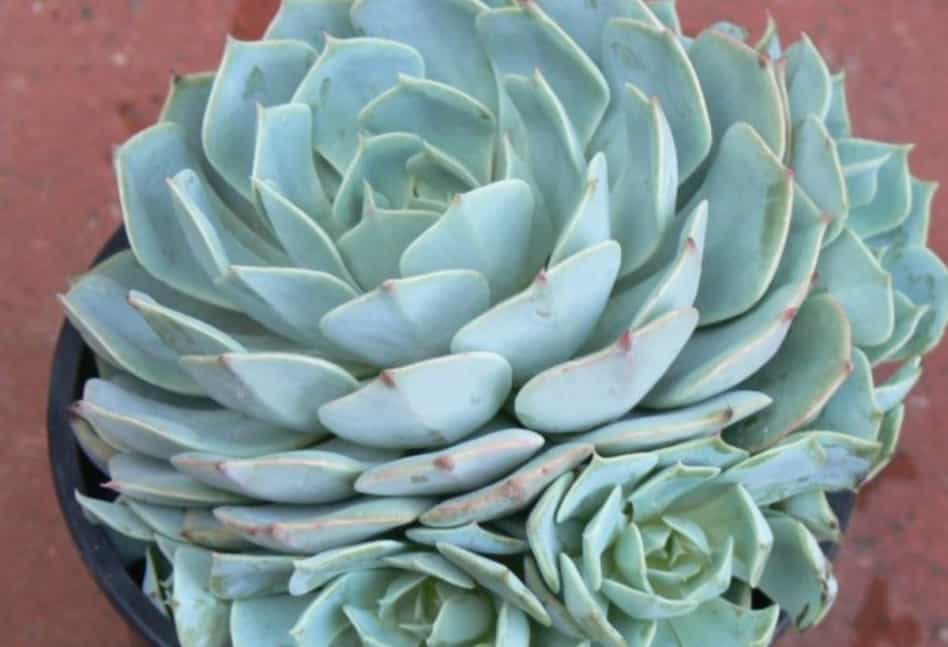

Echeveria Lau (E. laui) is a very popular stemless succulent in indoor floriculture with a delicate bluish-white rosette of large succulent leaves covered with a thick layer of wax bloom. The plant reaches 15-20 cm in circumference. The flowers are picturesque, bright orange, like porcelain, and are also clothed in a wax layer.
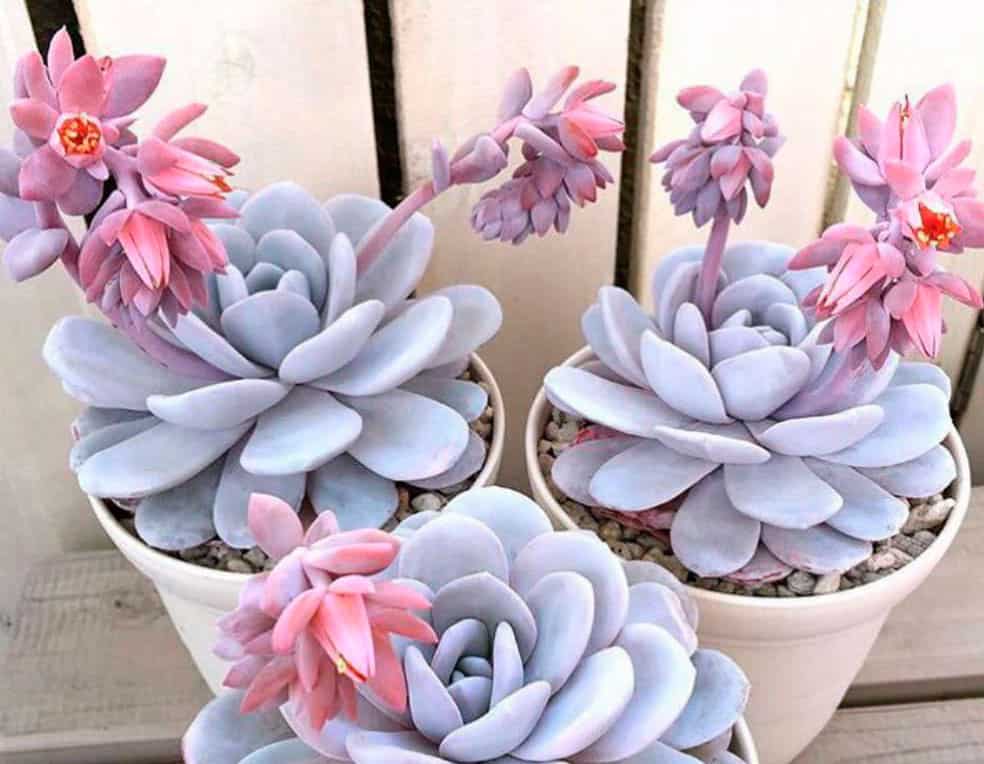

Echeveria Desmet (E. desmetiana) is a compact perennial with bluish foliage. In mature plants, the stem grows long; they are often cultivated as ampelous plants. The flowers are orange-yellow, open in the second half of summer.


Echeveria Shaviana (E. shaviana) is a succulent that resembles a head of cabbage in its appearance. Its stem is short, and the foliage is not as fleshy as that of many relatives.Leaf blades with wavy edges are packed tightly into a rosette. At the peak of summer, it forms 2-3 flowering pagons, on the crown of which about 20 flowers open in turn. During dormancy, it loses most of the crown.


Echeveria pulidonis (E. pulidonis) is a bluish succulent with elongated leaf blades, the tops of which are bordered with a reddish edging.
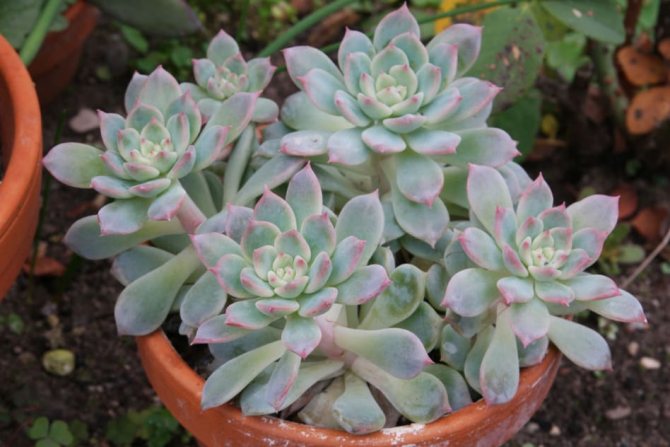

Echeveria humpback-flowered (E. gibbiflora) is a subshrub with an erect, slightly branched stem and large gray-green foliage that forms an apical rosette. Differs in bright inflorescence, consisting of 30-60 miniature reddish flowers. In indoor floriculture, hybrid varieties "Pearl of Nuremberg" (E. gibbiflora Perle von Nurnberg) and "Metallica" (E. gibbiflora Metallica) with pinkish-gray leaves are very popular.


Echeveria bristly (E. setosa) is a perennial with a small stem about 10 cm, around which a rosette of up to 15 cm is formed in a circle of obverse lanceolate leaves covered with light pubescence. Inflorescences are coral yellow.


Echeveria mexicana (E. mexicana) is a succulent that forms a rosette of medium-sized triangular leaves of a rich dark emerald hue, bordered by an elegant reddish edging.
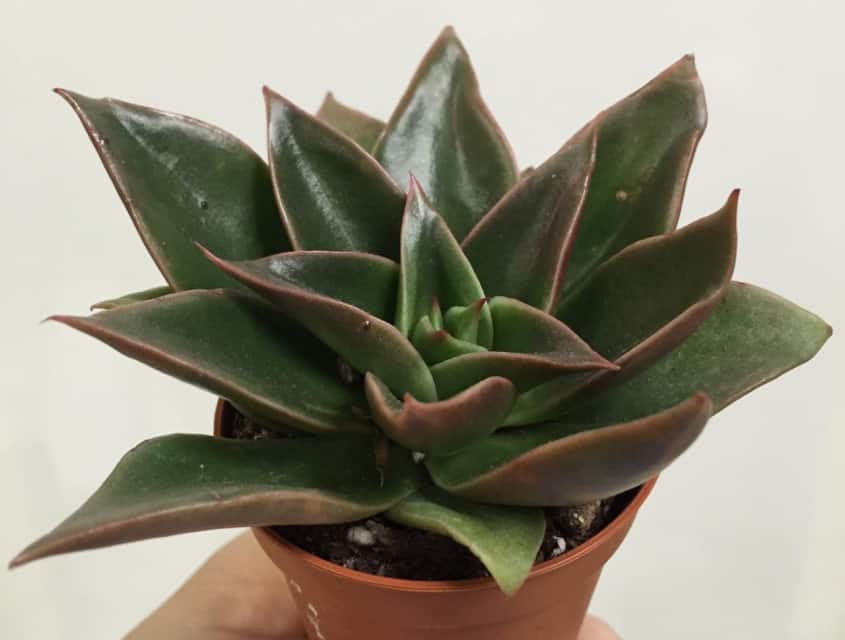

Echeveria amoena (E. amoena) - differs in flat, actively branching shoots, similar to mini-trees with rosettes of small bluish triangular leaves. It blooms with yellowish inflorescences, which acquire a reddish tint in the bright sun.
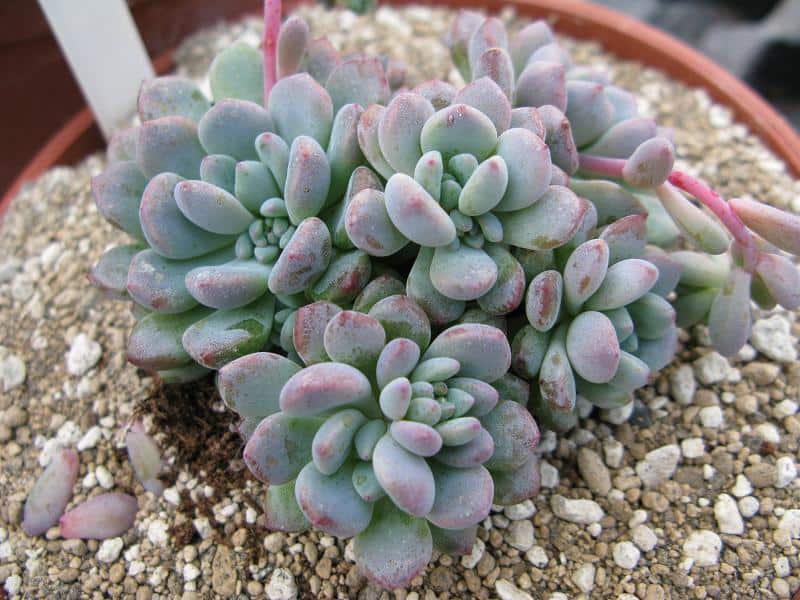

Echeveria white-haired (E. leucotricha) is a succulent shrub no more than 20 cm in height with dense reddish-brown villi covering the stem. The rosette is loose, formed by lanceolate leaf blades densely covered with soft whitish pubescence.
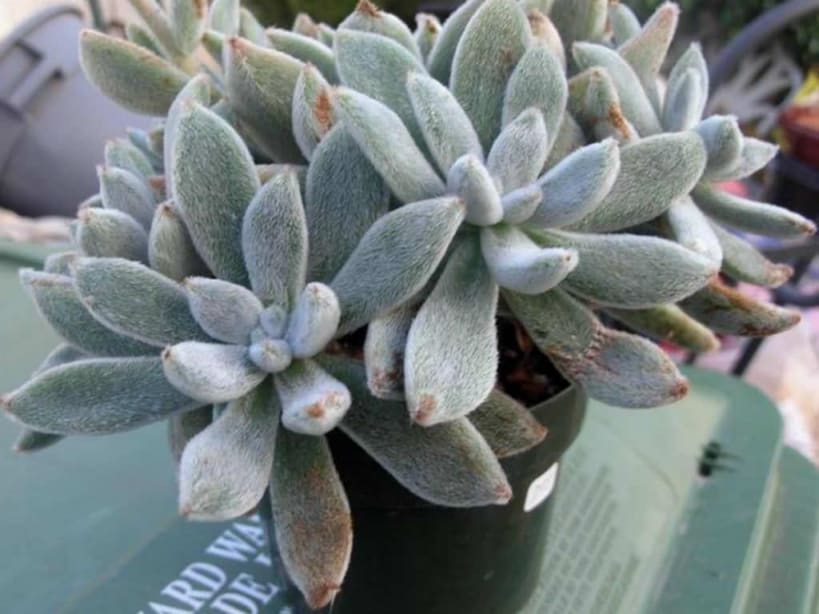

Echeveria brilliant (E. fulgens) - unbranched dwarf shrubs with thick short stems and gray-green foliage, wavy at the edges.
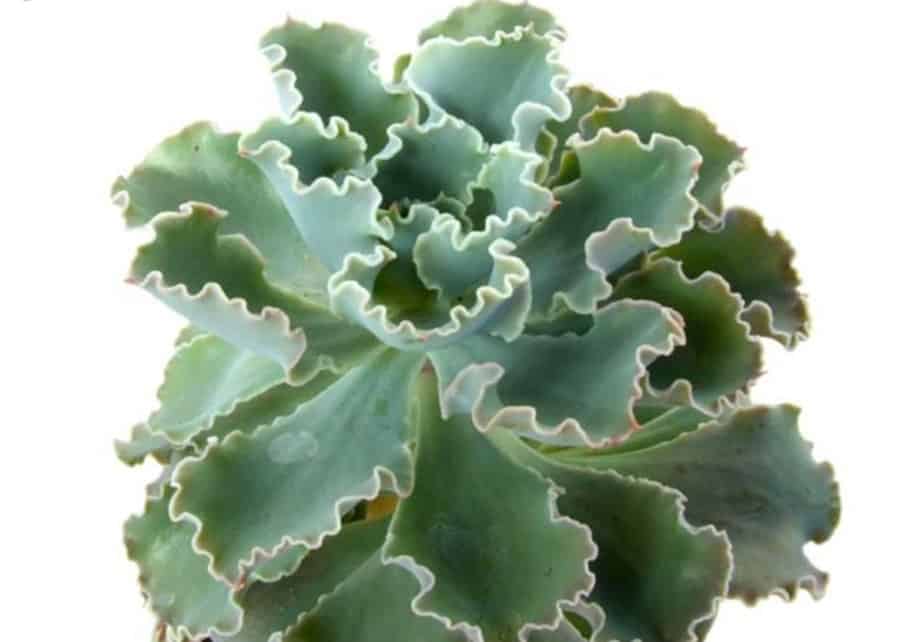

Description
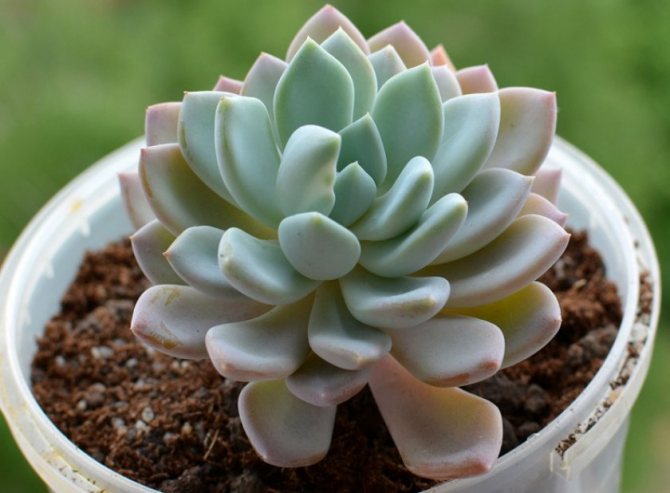

The genus Echeveria belongs to the Tolstyankov family. According to various sources, it includes from 150 to 180 representatives. Most of them are found naturally, like the other house plant ruelia, in Mexico and the southern United States. Some species grow in South America, Peru. Succulents grow on plains or in low mountains, where it is always hot and sunny in summer, and there are minor and short frosts in winter. The plant got its name by the name of Atanasio Echeverria Godoy, an artist from Mexico who was fond of botany. He made drawings for books describing the plants of his homeland.
On a note! A feature of Echeveria or Echeveria, as this plant is also called, is the ability to cross between species. Thanks to her, botanists managed to get interesting hybrids. Pachyveria was obtained by crossing with pachyphytum, and graptoveria was the result of combining with graptopetalum.
All echeveria are evergreen succulent perennials. Most of them belong to grasses, but there are dwarf shrubs. These plants do not have a stem. Instead, a short, thick trunk grows. Florists appreciate Echeveria for its decorative leaves. In most species, they are even, fleshy, with a smooth surface. The leaf plates are covered with a silvery, grayish or whitish coating. It protects plants from the scorching rays of the sun. Some species have pubescence instead of plaque. The layer thickness increases as the air temperature rises. Then the leaves take on a bluish tint and a red border around the edge.
Echeveria's leaves grow often, twist in a spiral into a dense rosette. Outwardly, they resemble a flower. The unusual shade of the leaf plates gives even greater similarity. They are painted in a pale green shade with a slight touch of gray, purple or red. Depending on the species, the length of the leaf plates is from 3 to 30 cm, and the width is from 1.5 to 15 cm. In plants growing at home, the leaves are half as large. Below is a photo of the echeveria plant.
During flowering, Echeveria produces a high peduncle. It grows from the middle of the rosette and reaches a height of 38 to 85 cm. Many small bell-shaped flowers bloom on it. They form an inflorescence in the form of an umbrella, spike or brush. The buds are colored yellowish-orange, brighter on the outside. In its natural environment, echeveria blooms in early summer and lasts 2-3 weeks. After pollination, fruits are formed in the form of boxes with small brown seeds inside.
